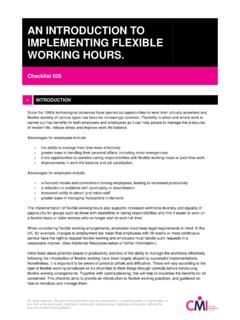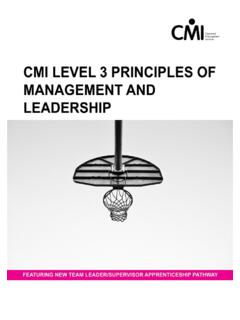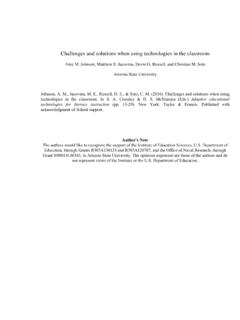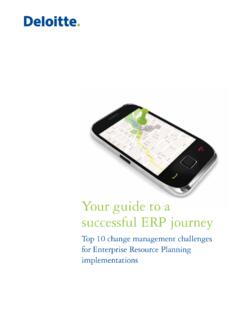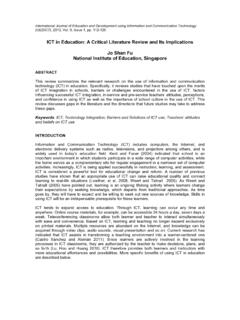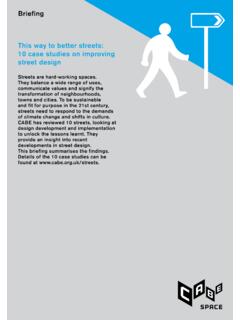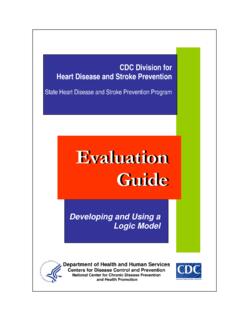Transcription of STEPS IN SUCCESSFUL TEAM BUILDING.
1 STEPS IN SUCCESSFUL . team building . Checklist 088. INTRODUCTION. Teams have become a common feature of organisational life. Workplace teams are used to carry out projects of various kinds and can make a significant contribution to organisational success, but the development of good working relationships is vital to team performance. Organisations that take the time to invest in building effective teams will reap the benefits of improved morale, better performance and the SUCCESSFUL completion of projects. Good leadership is a key to team performance and team leaders have a vital role to play in ensuring that team members work well together and are able to achieve the goals which have been set. Their role is that of facilitator. They need to understand the nature of the task in hand as well as the broader organisational context. They need to assess the knowledge, skills and experience of each team members and what motivates them. They need to engage individuals and help them to find their place in the work of the team .
2 SUCCESSFUL team building can: coordinate the efforts of individuals as they tackle complex tasks make the most of expertise and knowledge which might otherwise remain untapped build on the complementary strengths of team members to produce results which could not be achieved by employees working individually raise and sustain motivation and confidence as team members feel supported and involved encourage members to work together to generate fresh ideas solve problems, and find new ways forward help to break down communication barriers and avoid unhealthy competition, rivalry and point- scoring between departments raise the level of individual and collective empowerment enhance engagement with and ownership of the task in hand. This checklist outlines STEPS in the development of workplace teams and covers the main issues which team leaders need to address. Its focus is on co-located rather than virtual or remote teams. Our checklist on Communicating in the Virtual Workplace provides more information on managing virtual teams.
3 (See Related checklists below). DEFINITION. A team is more than just a group of people who happen to work together. It is a group of people working towards common goals and objectives and sharing responsibility for the outcomes. Increasingly, a team may be composed of people drawn from different functions, departments and disciplines who have been brought together for a specific project. team building begins with the effective selection and grouping of All rights reserved. No part of this publication may be reproduced in a retrieval system, or transmitted, in any form or by any means, electronic, mechanical, photocopying, recording or otherwise, without the prior permission of the publisher. team members. It includes the encouragement of good working relationships and practices, which enable the team to steer and develop the work and reach their goals. ACTION CHECKLIST. 1. Consider whether a team is the best option Don't assume that a team is necessarily the best way of achieving the objectives you have in mind.
4 Think carefully about the tasks to be completed and the skills required before launching into the formation of a team . Consider whether there is a need for a mix of skills and experience, the sharing of workloads, or for brainstorming and problem solving. In such cases a team will often be the best option. Otherwise, ask yourself whether the task can be more effectively carried out by a single person with the relevant knowledge and skills. It is important to weigh the advantages and disadvantages of team working there may be losses in coordination and motivation if teams are not carefully developed and managed. Organisational culture should also be considered - teamwork may be difficult, for example, in an organisation with a culture of rigid reporting structures or fixed work procedures. 2. Define objectives and the skills needed to reach them Think carefully about the nature of the tasks or projects to be carried out by the team and the mix of knowledge and skills needed. For teams handling routine tasks on a long term basis, low levels of diversity in the team and clear definitions of tasks and roles are required.
5 In this context, the key aims would be high levels of team cohesion and commitment and low levels of conflict. For innovation and problem solving, on the other hand, high levels of diversity and complementary skills will be required and the definition of goals and roles may be left to the team . This might involve losses in coordination, much less cohesion, and fairly high potential for conflict, but could be worthwhile if new ideas and solutions are required. 3. Consider the make-up of the team If you are forming a new team , you need to consider the number of people involved, their cultural backgrounds and the skill set they bring to the team . If you are setting up an international or multi-cultural team you may wish to study Geert Hofstede's work on cultural differences. This will give you a better understanding of issues such as differing attitudes to authority, individual responsibility and uncertainty avoidance. (See Related thinkers below). In many organisations, however the selection of team members will be outside the remit of the team leader.
6 In such cases the process of developing good working relationships and practices within the team is even more vital to success. The work of R Meredith Belbin provides some useful insights into the patterns of behaviour exhibited by team members and the way they interact with each other. You may wish to take these into account when putting a team together or seeking to shape an existing team . Belbin identifies a number of roles which team members can play and their respective strengths and weaknesses. He suggests that teams need a balance of members with differing roles if they are to work together effectively. Furthermore an understanding of personal differences and roles can help team members to cooperate more successfully, complementing each other's strengths. (See Related thinkers below for more on Belbin's work.). Teams with a strong focus on innovation who need to develop new ideas may benefit from members with who can think in different ways to analyse problems and find solutions.
7 Edward De Bono's six thinking hats' model of thinking styles may be helpful here. (See Related models below). All rights reserved. No part of this publication may be reproduced in a retrieval system, or transmitted, in any form or by any means, electronic, mechanical, photocopying, recording or otherwise, without the prior permission of the publisher. 4. Plan your team building strategy The following aspects must be considered: a climate of trust nurturing team culture is a vital part of the team leader's role. Mistakes and failures should be seen as learning experiences, not as occasions to apportion blame communication clear and frequent communication is vital. The free flow of information will help team members understand how their work contributes to business objectives and promote better integration training specialist training may be needed to handle the tasks required, especially if the team leader has not been able to select team members personally. team leaders will need project management skills and the ability to manage meetings, moderate discussions and handle conflict.
8 team members will also need good interpersonal skills, including communication and negotiation. time ensure that there is time to coordinate activities, to develop ideas and to monitor progress and that there are opportunities for regular meetings. Be aware that attitudes to time differ significantly across cultures resources make sure that the team has access to the resources and materials they will need to complete their work objectives these need to be clearly understood by all team members. This is increasingly a matter of involving team members in setting objectives rather than dictating prescribed objectives to them. team members with a clear understanding of their own objectives and their place within the team and the wider organisation are more likely to be able to motivate themselves to achieve, and to exhibit higher levels of job satisfaction, commitment, excitement and enthusiasm tasks and roles it is vital for team members to be absolutely clear about what is expected of them and what tasks have to be carried out.
9 Consider how you will handle the situation if tasks and roles are not respected feedback - everybody needs to know how well they are doing and if and where improvements can be made. Feedback should focus firstly on the positive aspects and then on ways of addressing any problems or difficulties. You may also consider bringing in someone with team building experience to help with the initial phases, especially if the team 's task is major or complex. Alternatively, consider whether team building activities such as outbound team building , games or process labs would be helpful and appropriate. 5. Get the team together From the outset you should aim to start to encourage the group to see themselves as a team , rather than a collection of individuals. At the initial meeting, discuss and agree the overall objectives the team is to achieve, rather than attempting to address tasks in detail. Make sure that everyone understands their personal contribution to the team 's success, its place in the project schedule and its importance to the project's success.
10 Bear in mind that most teams pass through several stages of development before starting to produce their best work. Bruce Tuckman's 1965 model of team development presents this process in the following stages: forming - as team members come together storming as they work through the issues norming as conflicts are resolved and working practices and expectations are established performing as objectives are achieved. (See Related models below for further information.). Bear in mind that these stages vary in importance depending on the type of task being carried out. For example, in the case of routine tasks, groups should proceed more quickly to performing. Teams with innovative tasks will need more time for forming and storming and may find it difficult to reach the performing stage. Once a problem-solving strategy has been found by an innovative' team , it may be All rights reserved. No part of this publication may be reproduced in a retrieval system, or transmitted, in any form or by any means, electronic, mechanical, photocopying, recording or otherwise, without the prior permission of the publisher.

